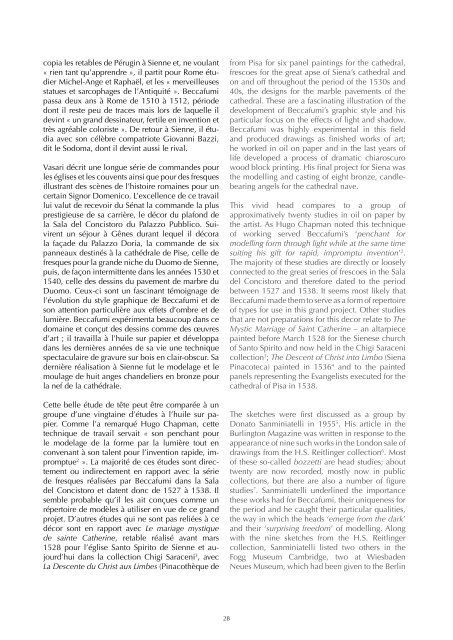You also want an ePaper? Increase the reach of your titles
YUMPU automatically turns print PDFs into web optimized ePapers that Google loves.
copia les retables <strong>de</strong> Pérugin à Sienne et, ne voulant<br />
« rien tant qu’apprendre », il partit pour Rome étudier<br />
Michel-Ange et Raphaël, et les « merveilleuses<br />
statues et sarcophages <strong>de</strong> l’Antiquité ». Beccafumi<br />
passa <strong>de</strong>ux ans à Rome <strong>de</strong> 1510 à 1512, pério<strong>de</strong><br />
d<strong>on</strong>t il reste peu <strong>de</strong> traces mais lors <strong>de</strong> laquelle il<br />
<strong>de</strong>vint « un grand <strong>de</strong>ssinateur, fertile en inventi<strong>on</strong> et<br />
très agréable coloriste ». De retour à Sienne, il étudia<br />
avec s<strong>on</strong> célèbre compatriote Giovanni Bazzi,<br />
dit le Sodoma, d<strong>on</strong>t il <strong>de</strong>vint aussi le rival.<br />
Vasari décrit une l<strong>on</strong>gue série <strong>de</strong> comman<strong>de</strong>s pour<br />
les églises et les couvents ainsi que pour <strong>de</strong>s fresques<br />
illustrant <strong>de</strong>s scènes <strong>de</strong> l’histoire romaines pour un<br />
certain Signor Domenico. L’excellence <strong>de</strong> ce travail<br />
lui valut <strong>de</strong> recevoir du Sénat la comman<strong>de</strong> la plus<br />
prestigieuse <strong>de</strong> sa carrière, le décor du plaf<strong>on</strong>d <strong>de</strong><br />
la Sala <strong>de</strong>l C<strong>on</strong>cistoro du Palazzo Pubblico. Suivirent<br />
un séjour à Gênes durant lequel il décora<br />
la faça<strong>de</strong> du Palazzo Doria, la comman<strong>de</strong> <strong>de</strong> six<br />
panneaux <strong>de</strong>stinés à la cathédrale <strong>de</strong> Pise, celle <strong>de</strong><br />
fresques pour la gran<strong>de</strong> niche du Duomo <strong>de</strong> Sienne,<br />
puis, <strong>de</strong> faç<strong>on</strong> intermittente dans les années 1530 et<br />
1540, celle <strong>de</strong>s <strong>de</strong>ssins du pavement <strong>de</strong> marbre du<br />
Duomo. Ceux-ci s<strong>on</strong>t un fascinant témoignage <strong>de</strong><br />
l’évoluti<strong>on</strong> du style graphique <strong>de</strong> Beccafumi et <strong>de</strong><br />
s<strong>on</strong> attenti<strong>on</strong> particulière aux effets d’ombre et <strong>de</strong><br />
lumière. Beccafumi expérimenta beaucoup dans ce<br />
domaine et c<strong>on</strong>çut <strong>de</strong>s <strong>de</strong>ssins comme <strong>de</strong>s œuvres<br />
d’art ; il travailla à l’huile <str<strong>on</strong>g>sur</str<strong>on</strong>g> papier et développa<br />
dans les <strong>de</strong>rnières années <strong>de</strong> sa vie une technique<br />
spectaculaire <strong>de</strong> gravure <str<strong>on</strong>g>sur</str<strong>on</strong>g> bois en clair-obscur. Sa<br />
<strong>de</strong>rnière réalisati<strong>on</strong> à Sienne fut le mo<strong>de</strong>lage et le<br />
moulage <strong>de</strong> huit anges chan<strong>de</strong>liers en br<strong>on</strong>ze pour<br />
la nef <strong>de</strong> la cathédrale.<br />
Cette belle étu<strong>de</strong> <strong>de</strong> tête peut être comparée à un<br />
groupe d’une vingtaine d’étu<strong>de</strong>s à l’huile <str<strong>on</strong>g>sur</str<strong>on</strong>g> papier.<br />
Comme l’a remarqué Hugo Chapman, cette<br />
technique <strong>de</strong> travail servait « s<strong>on</strong> penchant pour<br />
le mo<strong>de</strong>lage <strong>de</strong> la forme par la lumière tout en<br />
c<strong>on</strong>venant à s<strong>on</strong> talent pour l’inventi<strong>on</strong> rapi<strong>de</strong>, impromptue<br />
2 ». La majorité <strong>de</strong> ces étu<strong>de</strong>s s<strong>on</strong>t directement<br />
ou indirectement en rapport avec la série<br />
<strong>de</strong> fresques réalisées par Beccafumi dans la Sala<br />
<strong>de</strong>l C<strong>on</strong>cistoro et datent d<strong>on</strong>c <strong>de</strong> 1527 à 1538. Il<br />
semble probable qu’il les ait c<strong>on</strong>çues comme un<br />
répertoire <strong>de</strong> modèles à utiliser en vue <strong>de</strong> ce grand<br />
projet. D’autres étu<strong>de</strong>s qui ne s<strong>on</strong>t pas reliées à ce<br />
décor s<strong>on</strong>t en rapport avec Le mariage mystique<br />
<strong>de</strong> sainte Catherine, retable réalisé avant mars<br />
1528 pour l’église Santo Spirito <strong>de</strong> Sienne et aujourd’hui<br />
dans la collecti<strong>on</strong> Chigi Saraceni 3 , avec<br />
La Descente du Christ aux Limbes (Pinacothèque <strong>de</strong><br />
from Pisa for six panel paintings for the cathedral,<br />
frescoes for the great apse of Siena’s cathedral and<br />
<strong>on</strong> and off throughout the period of the 1530s and<br />
40s, the <strong>de</strong>signs for the marble pavements of the<br />
cathedral. These are a fascinating illustrati<strong>on</strong> of the<br />
<strong>de</strong>velopment of Beccafumi’s graphic style and his<br />
particular focus <strong>on</strong> the effects of light and shadow.<br />
Beccafumi was highly experimental in this field<br />
and produced drawings as finished works of art;<br />
he worked in oil <strong>on</strong> paper and in the last years of<br />
life <strong>de</strong>veloped a process of dramatic chiaroscuro<br />
wood block printing. His final project for Siena was<br />
the mo<strong>de</strong>lling and casting of eight br<strong>on</strong>ze, candlebearing<br />
angels for the cathedral nave.<br />
This vivid head compares to a group of<br />
approximatively twenty studies in oil <strong>on</strong> paper by<br />
the artist. As Hugo Chapman noted this technique<br />
of working served Beccafumi’s ‘penchant for<br />
mo<strong>de</strong>lling form through light while at the same time<br />
suiting his gift for rapid, impromptu inventi<strong>on</strong>’ 2 .<br />
The majority of these studies are directly or loosely<br />
c<strong>on</strong>nected to the great series of frescoes in the Sala<br />
<strong>de</strong>l C<strong>on</strong>cistoro and therefore dated to the period<br />
between 1527 and 1538. It seems most likely that<br />
Beccafumi ma<strong>de</strong> them to serve as a form of repertoire<br />
of types for use in this grand project. Other studies<br />
that are not preparati<strong>on</strong>s for this <strong>de</strong>cor relate to The<br />
Mystic Marriage of Saint Catherine – an altarpiece<br />
painted before March 1528 for the Sienese church<br />
of Santo Spirito and now held in the Chigi Saraceni<br />
collecti<strong>on</strong> 3 ; The Descent of Christ into Limbo (Siena<br />
Pinacoteca) painted in 1536 4 and to the painted<br />
panels representing the Evangelists executed for the<br />
cathedral of Pisa in 1538.<br />
The sketches were first discussed as a group by<br />
D<strong>on</strong>ato Sanminiatelli in 1955 5 . His article in the<br />
Burlingt<strong>on</strong> Magazine was written in resp<strong>on</strong>se to the<br />
appearance of nine such works in the L<strong>on</strong>d<strong>on</strong> sale of<br />
drawings from the H.S. Reitlinger collecti<strong>on</strong> 6 . Most<br />
of these so-called bozzetti are head studies; about<br />
twenty are now recor<strong>de</strong>d, mostly now in public<br />
collecti<strong>on</strong>s, but there are also a number of figure<br />
studies 7 . Sanminiatelli un<strong>de</strong>rlined the importance<br />
these works had for Beccafumi, their uniqueness for<br />
the period and he caught their particular qualities,<br />
the way in which the heads ‘emerge from the dark’<br />
and their ‘<str<strong>on</strong>g>sur</str<strong>on</strong>g>prising freedom’ of mo<strong>de</strong>lling. Al<strong>on</strong>g<br />
with the nine sketches from the H.S. Reitlinger<br />
collecti<strong>on</strong>, Sanminiatelli listed two others in the<br />
Fogg Museum Cambridge, two at Wiesba<strong>de</strong>n<br />
Neues Museum, which had been given to the Berlin<br />
28















